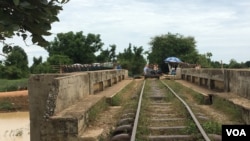The world-famous bamboo railway in Battambang, which was closed in October last year, has reopened to the public in a new location.
The railway, popular with foreign tourists, was shuttered as the government moved ahead with plans to rebuild the country’s northern railroad, built during the French colonial period, that link Phnom Penh with the Thai border.
Chan Samleng, director of the railroad department, said the extended railway would open in July.
The old section of the northern railroad had been used by local villagers for more than two decades to carry people and freight to the border, as well as taking tourists on short trips in Battambang.
Chum Nhor, district governor, said the provincial authorities had cooperated with investors to open the new railway in Banon district, adding that he believed the new location offered more potential than before as tourists would be able to travel through forests, mountains, and caves along the route.
“This is just the first phase. We are going to have more rail lines [about 24 kilometers] around Banon mountain,” he said, adding that local people would benefit from the new railway as they could sell produce to passing tourists.
“The tourists can see the natural forests of around 800 hectares that the community people have protected. Tourists can also see the bat cave,” he added.
Additional trains would be added to the railway at the end of the month, he said.
The bamboo train, or nori in the Khmer language, is a small wooden-framed deck that sits on top of two independent axles, reclaimed from damaged tanks left over from the civil war. Each cart costs about $500 to build.
The closure of the railway in October has, however, had a negative impact on some former drivers.
Sorn Bora, 41, who had worked as a bamboo cart driver for more than a decade, said he would not relocate to the new location as it was too far from his home and family.
“It is far from my home,” said Bora, who now drives a motorbike taxi to earn a living. He added that the former drivers were concerned by the safety of the new setup as the railway went up and down several hills.
“I wouldn’t drive there. The road is down and up. I don’t dare. I am afraid of the brakes coming loose and it can cause danger to the tourists,” he said.
Another driver, Pheach Tum, 52, said he would continue to drive a cart near the old location on a section of railway not affected by the changes, earning about $5 per day, a drop of 50 percent compared with his past earnings.
Sorng Te, who oversees tourism at the new site, said bamboo train drivers there would be paid about $225 per month and given $2.50 a day in dividends by investors.
“It’s just getting started. There are not many foreign tourists yet,” he said.








